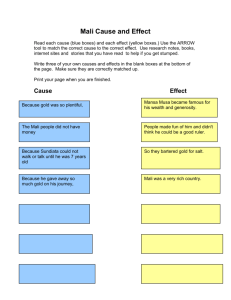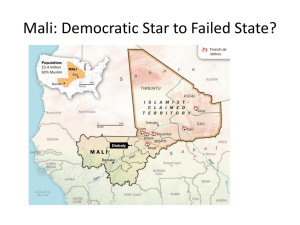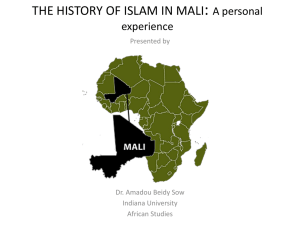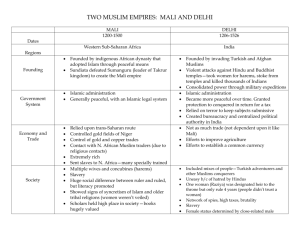Economic Bases of Ancient Ghana and Mali
advertisement
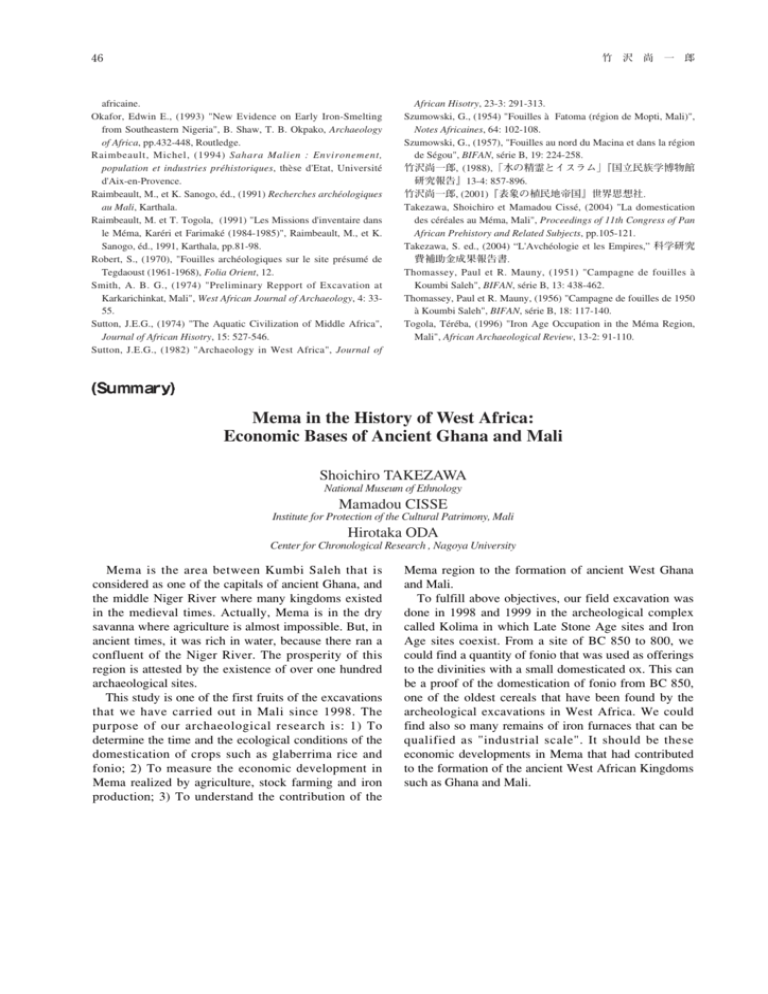
竹 沢 尚 一 郎 46 africaine. Okafor, Edwin E., (1993) "New Evidence on Early Iron-Smelting from Southeastern Nigeria", B. Shaw, T. B. Okpako, Archaeology of Africa, pp.432-448, Routledge. Raimbeault, Michel, (1994) Sahara Malien : Environement, population et industries préhistoriques, thèse d'Etat, Université d'Aix-en-Provence. Raimbeault, M., et K. Sanogo, éd., (1991) Recherches archéologiques au Mali, Karthala. Raimbeault, M. et T. Togola, (1991) "Les Missions d'inventaire dans le Méma, Karéri et Farimaké (1984-1985)", Raimbeault, M., et K. Sanogo, éd., 1991, Karthala, pp.81-98. Robert, S., (1970), "Fouilles archéologiques sur le site présumé de Tegdaoust (1961-1968), Folia Orient, 12. Smith, A. B. G., (1974) "Preliminary Repport of Excavation at Karkarichinkat, Mali", West African Journal of Archaeology, 4: 3355. Sutton, J.E.G., (1974) "The Aquatic Civilization of Middle Africa", Journal of African Hisotry, 15: 527-546. Sutton, J.E.G., (1982) "Archaeology in West Africa", Journal of African Hisotry, 23-3: 291-313. Szumowski, G., (1954) "Fouilles à Fatoma (région de Mopti, Mali)", Notes Africaines, 64: 102-108. Szumowski, G., (1957), "Fouilles au nord du Macina et dans la région de Ségou", BIFAN, série B, 19: 224-258. 竹沢尚一郎, (1988),「水の精霊とイスラム」『国立民族学博物館 研究報告』13-4: 857-896. 竹沢尚一郎, (2001)『表象の植民地帝国』世界思想社. Takezawa, Shoichiro et Mamadou Cissé, (2004) "La domestication des céréales au Méma, Mali", Proceedings of 11th Congress of Pan African Prehistory and Related Subjects, pp.105-121. Takezawa, S. ed., (2004) “L'Avchéologie et les Empires,” 科学研究 費補助金成果報告書. Thomassey, Paul et R. Mauny, (1951) "Campagne de fouilles à Koumbi Saleh", BIFAN, série B, 13: 438-462. Thomassey, Paul et R. Mauny, (1956) "Campagne de fouilles de 1950 à Koumbi Saleh", BIFAN, série B, 18: 117-140. Togola, Téréba, (1996) "Iron Age Occupation in the Méma Region, Mali", African Archaeological Review, 13-2: 91-110. Mema in the History of West Africa: Economic Bases of Ancient Ghana and Mali Shoichiro TAKEZAWA National Museum of Ethnology Mamadou CISSE Institute for Protection of the Cultural Patrimony, Mali Hirotaka ODA Center for Chronological Research , Nagoya University Mema is the area between Kumbi Saleh that is considered as one of the capitals of ancient Ghana, and the middle Niger River where many kingdoms existed in the medieval times. Actually, Mema is in the dry savanna where agriculture is almost impossible. But, in ancient times, it was rich in water, because there ran a confluent of the Niger River. The prosperity of this region is attested by the existence of over one hundred archaeological sites. This study is one of the first fruits of the excavations that we have carried out in Mali since 1998. The purpose of our archaeological research is: 1) To determine the time and the ecological conditions of the domestication of crops such as glaberrima rice and fonio; 2) To measure the economic development in Mema realized by agriculture, stock farming and iron production; 3) To understand the contribution of the Mema region to the formation of ancient West Ghana and Mali. To fulfill above objectives, our field excavation was done in 1998 and 1999 in the archeological complex called Kolima in which Late Stone Age sites and Iron Age sites coexist. From a site of BC 850 to 800, we could find a quantity of fonio that was used as offerings to the divinities with a small domesticated ox. This can be a proof of the domestication of fonio from BC 850, one of the oldest cereals that have been found by the archeological excavations in West Africa. We could find also so many remains of iron furnaces that can be qualified as "industrial scale". It should be these economic developments in Mema that had contributed to the formation of the ancient West African Kingdoms such as Ghana and Mali.
